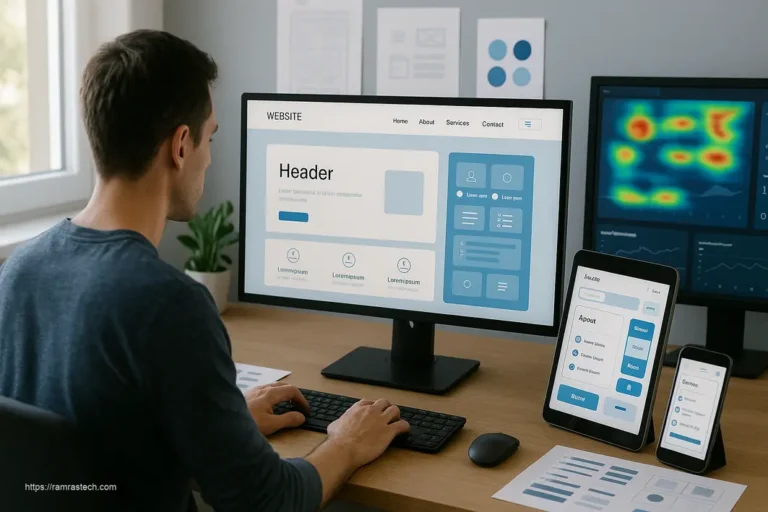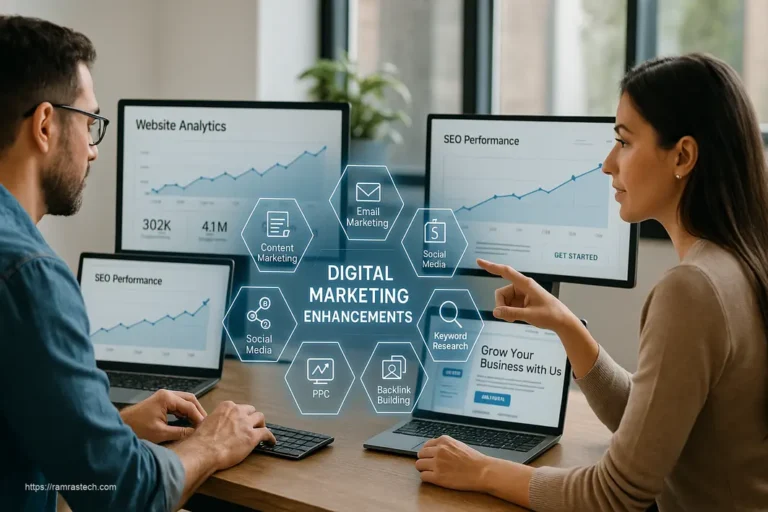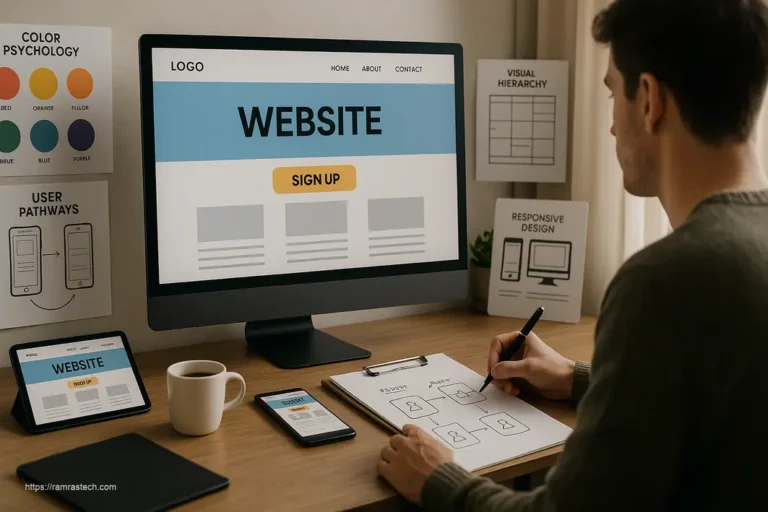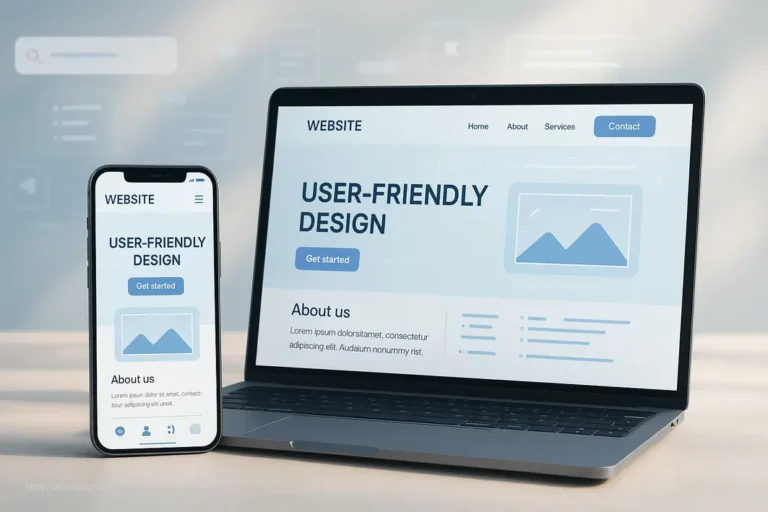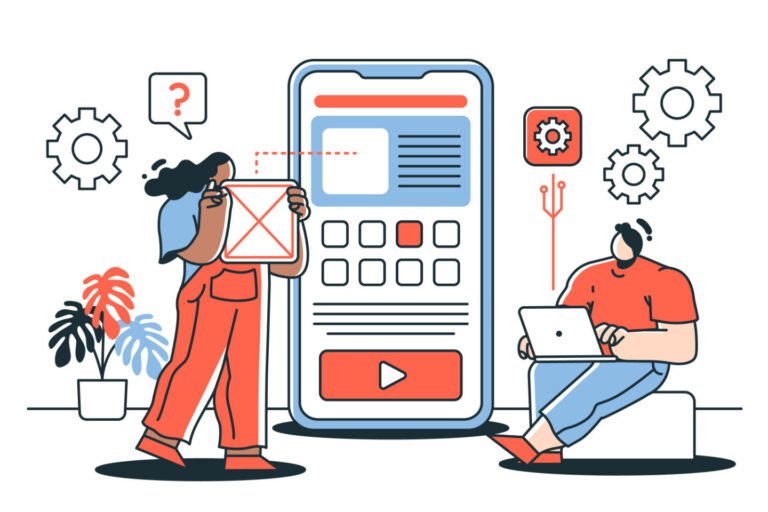7 Revolutionary Web Design Trends Enhancing UX in 2025

As we journey through 2025, the digital landscape continues to evolve at breakneck speed, pushing web designers to reimagine how users interact with online spaces. This year has brought a beautiful marriage of innovative aesthetics and human-centered functionality, creating digital experiences that don’t just look impressive – they feel intuitive and meaningful in ways we couldn’t have imagined just a few years ago.
The web design community has moved beyond fleeting visual trends to embrace approaches that genuinely enhance how people navigate, engage with, and experience websites. These aren’t just superficial changes – they’re transforming how brands connect with audiences and how users perceive their online journeys.
The Evolution of Human-Centered Design in 2025
Today’s web design philosophy places humans firmly at the center, acknowledging that a website must do more than simply exist – it must resonate emotionally while functioning flawlessly. The most successful sites of 2025 understand that users crave experiences that feel personal, intuitive, and effortless.
“Design is no longer about what looks cool – it’s about creating digital spaces where people actually want to spend time,” notes Jane Alvarez, UX Director at DesignFuture. “In 2025, we’re seeing websites that truly understand and anticipate human needs rather than forcing users to adapt to rigid interfaces.”
This shift reflects our deepening understanding of how people interact with digital spaces. With over 60% of web traffic now coming from mobile devices, designers must create experiences that translate seamlessly across platforms without sacrificing functionality or emotional impact.
8 Web Design Trends Revolutionizing User Experience in 2025
1. Purposeful Motion and Microinteractions
The days of gratuitous animations that slow down sites and distract users are behind us. In 2025, motion design has matured into a powerful storytelling tool that guides, informs, and delights users in meaningful ways.
Microinteractions – those tiny, almost subconscious moments of feedback when you hover over a button or complete a form – have evolved into sophisticated elements that communicate brand personality while providing crucial user guidance. From subtle cursor transformations to playful confirmation animations, these small touches create emotional connections that static designs simply can’t match.
“We’re seeing brands use microinteractions as genuine extensions of their identity,” says Marcus Chen, Interactive Designer at Pixel Innovation Labs. “A banking app might use calm, reassuring animations that convey security and trust, while a children’s educational site might implement more playful, energetic movements. These aren’t random design choices – they’re strategic emotional cues.”
What makes this trend particularly powerful is its emphasis on purpose. Every animation, transition, and interactive element serves a specific function in the user journey rather than existing merely as decoration.
2. Experimental Navigation Systems That Actually Work
Navigation has undergone a fascinating evolution in 2025. While traditional header menus still have their place, designers are reimagining how users move through digital spaces with innovative approaches that feel surprisingly intuitive:
- Contextual navigation that changes based on user behavior and previous interactions
- Spatial interfaces that use position and movement to create intuitive mental maps
- Sticky-scroll experiences where content reveals itself in unexpected but delightful ways
- Voice-activated navigation options that accommodate different accessibility needs
These experimental approaches work because they’re grounded in deep research about how humans naturally organize information and space. They challenge our expectations while still feeling somehow familiar.
The most successful implementations don’t force users to learn entirely new mental models. Instead, they build upon existing patterns in ways that feel like natural evolutions rather than jarring departures.
3. Scroll-Driven Storytelling
Scrolling has transformed from a basic navigation action into a powerful storytelling mechanism. In 2025, the act of scrolling often triggers carefully choreographed visual narratives that unfold as users move through a page.
Elements fade, zoom, or slide into view with perfect timing, creating a sense of discovery and progression that static designs simply can’t achieve. This approach transforms passive browsing into an active, engaging journey where users feel like participants rather than spectators.
“The magic happens when scrolling becomes more than just a way to see more content – it becomes part of the content itself,” explains Sophia Williams, Creative Director at Narrative Design Co. “We’re designing experiences where the act of scrolling actually advances the story or reveals information in ways that feel meaningful and intentional.”
This technique is particularly effective for brand storytelling, product showcases, and educational content where information needs to be presented in a logical sequence. When implemented thoughtfully, scroll-driven experiences increase engagement, improve information retention, and create memorable brand interactions.
4. Balanced White Space and Visual Hierarchy
In response to years of cluttered, overwhelming interfaces, 2025 has embraced the power of purposeful white space. This isn’t about minimalism for its own sake – it’s about creating breathing room that helps users focus on what truly matters.
“White space isn’t ’empty’ space – it’s working space,” notes design theorist Elena Rodriguez. “It directs attention, improves readability, and creates rhythm within a design. In 2025, we’re seeing brands understand that sometimes what you don’t include is as important as what you do.”
This approach is particularly evident in e-commerce, where product pages have moved away from cramming maximum information above the fold. Instead, they guide users through carefully paced experiences where each element has room to breathe and make an impact.
The strategic use of white space creates visual hierarchies that help users intuitively understand what’s most important on a page. In complex interfaces like dashboards and analytics platforms, this clarity isn’t just aesthetically pleasing – it’s essential for usability.
5. Immersive 3D Experiences That Serve a Purpose
After years of experimental 3D implementations that often felt gimmicky, 2025 has seen 3D mature into a purposeful design element that genuinely enhances user experiences when appropriate.
From product configurators that let customers visualize customizations in real-time to educational sites that use 3D models to explain complex concepts, these implementations add value rather than simply showing off technical capabilities.
“The key shift we’ve seen is designers asking ‘Does this 3D element help users accomplish their goals?’ rather than ‘Would a 3D element look cool here?'” explains Alex Thompson, Technical Director at Dimension Studios.
This maturation has been made possible by advancements in web technology that allow more efficient rendering of 3D elements, reducing the performance penalties that once made them impractical for many websites.
6. Accessibility as a Design Foundation
In 2025, accessibility has finally moved beyond being a checklist item to becoming a fundamental design principle that shapes projects from the very beginning.
The most progressive websites don’t just accommodate users with disabilities – they create experiences that are inherently more usable for everyone. This includes:
- Adaptive interfaces that respond to individual user preferences and needs
- Voice navigation options that benefit users with mobility limitations while offering convenience to all
- Thoughtful color systems designed with color vision deficiencies in mind
- Clear typography hierarchies that improve readability for everyone
“We’ve reached a tipping point where businesses understand that accessible design isn’t just ethically right – it’s commercially smart,” says Michael Patel, Accessibility Advocate at Inclusive Design Works. “When you design for the edges of user experience, you inevitably create something better for everyone.”
This shift has been accelerated by advancements in tools that make implementing accessibility features more straightforward, allowing designers to focus on creative solutions rather than technical hurdles.
7. Dynamic Personalization That Feels Natural
The websites of 2025 are increasingly able to adapt to individual users without feeling invasive or artificial. From subtle content recommendations to interface adjustments based on behavior patterns, personalization has become more sophisticated and valuable.
“The best personalization in 2025 is almost invisible,” notes Dr. Sarah Chen, UX Researcher at Adaptive Experiences. “It doesn’t announce itself – it simply makes the experience feel naturally aligned with what you need and want.”
This approach represents a significant evolution from earlier personalization attempts that often felt jarring or intrusive. The key difference is context – modern systems understand not just who the user is, but what they’re trying to accomplish in the moment.
E-commerce sites might subtly highlight products relevant to a user’s browsing history, while content platforms might adjust reading experiences based on past behavior. These adaptations enhance usefulness without disrupting the core experience.
8. Sustainable Web Design Practices
As awareness of the internet’s environmental impact has grown, 2025 has seen sustainability emerge as a genuine design consideration rather than just a marketing talking point.
Designers are increasingly mindful of how their choices affect energy consumption – from optimizing image sizes to questioning whether energy-intensive features like auto-playing videos are truly necessary.
“Sustainable web design isn’t about sacrificing beauty or functionality – it’s about being intentional with every element,” explains Jordan Hayes, Founder of GreenWeb Collective. “Do we really need that 4MB background video, or could we communicate the same feeling with a thoughtfully chosen image and subtle animation?”
This approach aligns perfectly with other UX trends – lighter, more efficient websites typically load faster, perform better on mobile devices, and create cleaner, more focused user experiences. It’s a rare win-win where environmental concerns and user needs point in the same direction.
Real-World Applications Transforming Industries
E-commerce: Beyond the Digital Shelf
The retail sector has perhaps benefited most dramatically from these web design trends. In 2025, shopping experiences have transcended basic product grids to become immersive journeys that blend the convenience of online shopping with the sensory richness of physical retail.
Product pages now commonly feature contextual scroll experiences that reveal information as users need it – specifications, reviews, and related items appear at just the right moment in the decision process. Microinteractions provide subtle feedback when items are added to carts or wishlists, creating satisfying moments of completion throughout the shopping journey.
“The most successful e-commerce sites in 2025 understand that online shopping isn’t just a transaction – it’s an experience,” says retail futurist Maya Johnson. “They’re using these design trends to create moments of discovery and delight that bring back some of the joy of physical shopping.”
Financial Services: Making Complexity Accessible
Financial websites and apps have leveraged these trends to transform traditionally intimidating experiences into approachable, human-centered journeys:
- Progressive disclosure techniques reveal complex information gradually
- Purposeful animations visualize abstract concepts like compound interest
- Thoughtful microinteractions provide reassurance during sensitive transactions
“Financial services have realized that being trusted isn’t just about security – it’s about making complex concepts understandable,” explains financial UX specialist Thomas Rivera. “These design approaches help bridge the gap between financial expertise and human understanding.”
Healthcare: Empathy Through Design
Healthcare platforms are using these design trends to create experiences that feel supportive and empathetic during what can be stressful situations for users:
- Calm, intentional interfaces with generous white space reduce cognitive load
- Careful navigation systems guide patients through complex processes
- Adaptive experiences accommodate different health literacy levels
“In healthcare, good design isn’t a luxury – it can be literally life-changing,” notes healthcare UX researcher Dr. Anita Kapoor. “When someone is trying to understand treatment options or book an urgent appointment, an intuitive, supportive interface makes all the difference.”
How to Implement These Trends Thoughtfully
While these trends offer exciting possibilities, they must be implemented with purpose and restraint. Here’s how to approach them effectively:
Start with User Needs, Not Visual Trends
Before implementing any design trend, ask: “How does this help our specific users accomplish their goals?” The most successful implementations begin with deep understanding of user needs rather than aesthetic preferences.
“Too many businesses still approach design trends as a shopping list – ‘we need microinteractions because everyone’s doing them,'” cautions UX strategist David Nguyen. “But without understanding why these elements work and whether they serve your specific audience, you’re just creating digital decoration.”
Prototype and Test with Real Users
Experimental navigation and interaction patterns should always be validated with actual users before full implementation. What seems intuitive to designers might be confusing to users unfamiliar with new patterns.
Iterative testing helps refine these elements to find the perfect balance between innovation and usability. This process often reveals surprising insights about how users actually interact with new design approaches.
Consider Performance Implications
Many of these trends – particularly animations, 3D elements, and personalization – can impact site performance if implemented carelessly. Always evaluate the technical implications and optimize accordingly.
“There’s no point creating a beautiful, engaging experience if users abandon it because it takes too long to load,” reminds performance specialist Rajiv Patel. “Every design decision has a technical cost that needs to be weighed against its benefit.”
FAQs About Web Design Trends in 2025
What is the most important web design trend for small businesses in 2025?
For small businesses with limited resources, focusing on purposeful simplicity is key. Clean, well-structured designs with strategic use of white space and thoughtful microinteractions can create professional, engaging experiences without requiring massive development budgets. Prioritize fast loading times, mobile optimization, and clear information architecture before implementing more technically complex trends.
How are accessibility concerns shaping web design trends in 2025?
Accessibility has become a fundamental design principle rather than an afterthought. Designers are creating more inclusive experiences through adaptive interfaces, improved color contrast, multiple navigation options, and thoughtful content structure. This approach not only serves users with disabilities but typically creates better experiences for all users, especially in challenging contexts like poor lighting or slow connections.
Are minimalist designs still relevant in 2025’s web design landscape?
Minimalism has evolved rather than disappeared. Rather than stark, featureless interfaces, 2025’s interpretation of minimalism focuses on emotional minimalism – removing unnecessary cognitive burdens while retaining personality and warmth. The emphasis is on purposeful simplicity that guides users’ attention and creates breathing room around important elements, rather than minimalism as a purely aesthetic choice.
How can businesses keep up with changing web design trends without constant redesigns?
The key is building flexible design systems rather than rigid templates. A well-constructed design system with modular components allows for evolutionary updates rather than complete overhauls. This approach enables businesses to incorporate new trends and patterns gradually while maintaining brand consistency and controlling costs. Focus on creating a solid foundation with thoughtful typography, color systems, and component libraries that can evolve over time.
How are AI and machine learning influencing web design trends in 2025?
AI is enabling more sophisticated personalization while paradoxically making experiences feel more human. From adaptive interfaces that learn user preferences to content recommendations that genuinely understand context, AI is working behind the scenes to create experiences that feel intuitive and responsive. The most effective implementations use AI to augment human creativity rather than replace it, creating experiences that combine technological capabilities with human emotional intelligence.
Embracing the Future While Staying Human
As we move through 2025, the most successful web designs will be those that thoughtfully implement these trends in service of human needs rather than technology for its own sake.
The true magic happens when innovative techniques enhance rather than overshadow the core purpose of a website – whether that’s selling products, sharing information, or connecting people. The best designs use technology to remove friction and create moments of delight, not to show off technical prowess.
“The web design trends of 2025 aren’t about flashy effects or fleeting aesthetics – they’re about creating digital spaces that respect and enhance the human experience,” reflects design philosopher Marcus Chen. “When we design with genuine empathy and purpose, we create websites that don’t just look current – they actually improve people’s lives in small but meaningful ways.”
As you consider how these trends might apply to your own website, remember that the most important question isn’t “What’s trending?” but rather “What helps my users accomplish their goals while creating meaningful connections with my brand?” Answer that question thoughtfully, and you’ll create digital experiences that remain relevant far beyond the trends of 2025.
By focusing on human needs first and technology second, we can create web experiences that don’t just capture attention – they earn trust, build relationships, and stand the test of time in our rapidly evolving digital world.

